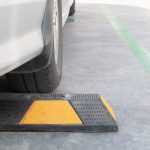Introduction
Definition of speed bumps
Speed bumps, also known as speed humps or speed breakers, are traffic calming devices that are designed to reduce vehicle speed and increase safety on roads. They are typically made of asphalt or concrete and are placed across the road at regular intervals. The purpose of speed bumps is to slow down vehicles, especially in areas where speeding is a concern, such as residential neighborhoods, school zones, or parking lots. By forcing drivers to slow down, speed bumps help to prevent accidents, protect pedestrians, and minimize the impact of vehicles on the surrounding environment.
Purpose of speed bumps
The purpose of speed bumps is to slow down vehicles and reduce their impact on the road. Speed bumps are typically installed in areas where there is a need to control vehicle speed, such as residential neighborhoods, school zones, and parking lots. By forcing drivers to slow down, speed bumps help to improve safety for pedestrians and other road users. They also serve as a reminder for drivers to be cautious and attentive while driving in these areas. Additionally, speed bumps can help to reduce noise and vibration caused by fast-moving vehicles, making the surrounding environment more peaceful and comfortable.
Importance of reducing vehicle impact
Reducing vehicle impact is of utmost importance for the safety and well-being of both drivers and pedestrians. Speed bumps play a crucial role in achieving this goal by effectively slowing down vehicles and minimizing the force of impact. By forcing drivers to reduce their speed, speed bumps help prevent accidents and protect vulnerable road users. They serve as a constant reminder to drivers to be cautious and attentive, creating a safer environment for everyone. Additionally, speed bumps also contribute to reducing noise pollution and promoting a more peaceful and serene neighborhood. Overall, the importance of reducing vehicle impact cannot be overstated, and speed bumps are an essential tool in achieving this objective.
Types of Speed Bumps
Traditional speed bumps
Traditional speed bumps are one of the most common traffic calming measures used to reduce vehicle speed and improve safety on roads. These raised sections of pavement are typically installed across the width of the road and are designed to force drivers to slow down. The main purpose of traditional speed bumps is to decrease vehicle speed and minimize the risk of accidents, particularly in areas with high pedestrian activity or near schools and residential areas. By creating a physical barrier that requires drivers to navigate over a raised surface, traditional speed bumps effectively encourage drivers to reduce their speed, resulting in safer road conditions for both drivers and pedestrians.
Speed humps
Speed humps are an effective traffic calming measure that is widely used to reduce vehicle speed and improve safety on residential streets. These raised platforms are strategically placed on the road to force drivers to slow down and navigate over them at a reduced speed. By creating a physical barrier, speed humps discourage drivers from speeding, resulting in a decrease in the risk of accidents and the severity of vehicle impacts. Additionally, rubber speed humps can also help to reduce noise pollution and enhance the overall quality of life in neighborhoods. Overall, speed humps play a crucial role in promoting safer and more livable communities.
Speed cushions
Speed cushions are a type of traffic calming measure that is designed to reduce vehicle speed and improve safety on roads. These raised platforms are typically installed in residential areas or school zones to slow down drivers and minimize the risk of accidents. Unlike traditional speed bumps, speed cushions are wider and have spaces in between, allowing larger vehicles such as buses and emergency vehicles to straddle them without causing discomfort. This makes speed cushions a more versatile and effective solution for controlling speed and ensuring the smooth flow of traffic. By implementing speed cushions, communities can create safer and more livable streets for pedestrians, cyclists, and motorists alike.
Design and Placement
Ideal dimensions of speed bumps
Ideal dimensions of speed bumps play a crucial role in effectively reducing vehicle impact. These dimensions include the height, width, and length of the speed bump. The height should be sufficient to slow down vehicles without causing discomfort or damage. The width should be wide enough to accommodate the entire width of a vehicle, ensuring that all wheels pass over the bump. The length should be long enough to provide a gradual approach and departure, minimizing abrupt jolts. By adhering to these ideal dimensions, speed bumps can effectively serve their purpose of slowing down vehicles and reducing the impact on roads and drivers.
Proper placement of speed bumps
Proper placement of speed bumps is crucial to ensure their effectiveness in reducing vehicle impact. It is important to strategically place speed bumps in areas where the speed of vehicles needs to be controlled, such as residential neighborhoods, school zones, and parking lots. By placing speed bumps in these locations, drivers are forced to slow down, promoting safer driving habits and reducing the risk of accidents. Additionally, proper placement of speed bumps should take into consideration factors such as visibility, road conditions, and the flow of traffic to ensure they do not cause any inconvenience or damage to vehicles. Overall, the proper placement of speed bumps plays a significant role in enhancing road safety and minimizing the impact of vehicles.
Considerations for visibility and signage
When installing speed bumps, it is crucial to consider visibility and signage to ensure the safety of drivers and pedestrians. Clear and prominent signage should be placed before the speed bumps to alert drivers of their presence. Additionally, the speed bumps themselves should be highly visible, either through bright colors or reflective materials, especially in low-light conditions. This visibility will help drivers slow down and navigate the speed bumps safely, reducing the risk of accidents and vehicle damage. By prioritizing visibility and signage, speed bumps can effectively fulfill their purpose of reducing vehicle impact.
Benefits of Speed Bumps
Reduced vehicle speed
Speed bumps are an effective measure to reduce vehicle speed and enhance road safety. By strategically placing these raised platforms on roads, drivers are compelled to slow down, preventing them from exceeding the speed limit. This reduction in speed not only reduces the risk of accidents but also minimizes the impact in case of a collision. Speed bumps are particularly useful in residential areas, school zones, and parking lots, where pedestrian safety is of utmost importance. By forcing drivers to slow down, speed bumps create a safer environment for both pedestrians and motorists, ultimately contributing to the overall well-being of the community.
Improved pedestrian safety
Speed bumps play a crucial role in improving pedestrian safety. By reducing the speed of vehicles, they provide pedestrians with a safer environment to cross the road. The presence of speed bumps forces drivers to slow down and be more cautious, minimizing the risk of accidents involving pedestrians. Additionally, speed bumps serve as a visual reminder for drivers to be vigilant and aware of their surroundings, particularly in areas with high foot traffic. Overall, the implementation of speed bumps significantly contributes to the enhanced safety of pedestrians, making roads a more secure place for everyone.
Decreased traffic accidents
Speed bumps have been proven to significantly decrease traffic accidents. By forcing drivers to slow down, speed bumps reduce the risk of collisions and the severity of accidents. They provide a visual and physical reminder for drivers to be cautious and attentive while driving. Additionally, speed bumps are often placed in areas with high pedestrian traffic, further enhancing safety by discouraging speeding and improving overall road awareness. Studies have shown that the presence of speed bumps can lead to a noticeable decrease in both the frequency and severity of traffic accidents, making them an effective tool for traffic management and safety.
Challenges and Concerns
Impact on emergency vehicles
Speed bumps have been proven to have a significant impact on emergency vehicles. While they are effective in reducing the speed of regular vehicles, they can pose a challenge for emergency vehicles that need to respond quickly to emergencies. The presence of speed bumps can slow down emergency vehicles, potentially delaying their arrival at the scene of an accident or emergency. This delay can have serious consequences, as every second counts in such situations. Therefore, it is important to carefully consider the placement and design of speed bumps to ensure they do not hinder the response time of emergency vehicles.
Noise and vibration
Noise and vibration are significant concerns when it comes to road safety and the overall driving experience. Speed bumps play a crucial role in reducing vehicle impact and subsequently minimizing noise and vibration. By forcing drivers to slow down, speed bumps help to control the noise generated by vehicles. Additionally, they also help to reduce the vibration caused by vehicles traveling at high speeds. This not only benefits the residents living near roads but also enhances the comfort and safety of drivers and passengers. Overall, speed bumps are an effective solution in mitigating noise and vibration, making roads quieter and more pleasant for everyone.
Potential damage to vehicles
Speed bumps are designed to reduce vehicle speed and improve safety on roads. However, they can also cause potential damage to vehicles. The abrupt change in speed can lead to increased wear and tear on the suspension, tires, and other components of the vehicle. This can result in costly repairs and maintenance for vehicle owners. Additionally, vehicles with low ground clearance may experience scraping or bottoming out when going over speed bumps, potentially causing damage to the undercarriage. It is important for drivers to approach speed bumps with caution and reduce their speed to minimize the risk of vehicle damage.
Alternative Solutions
Traffic calming measures
Traffic calming measures are designed to reduce the speed of vehicles and create a safer environment for pedestrians and cyclists. One effective traffic calming measure is the installation of speed bumps. Speed bumps are raised sections of pavement that force drivers to slow down in order to navigate over them. By introducing these physical obstacles, speed bumps help to reduce the speed of vehicles, thereby minimizing the impact of collisions and improving overall road safety. In addition to their role in reducing vehicle speed, speed bumps also serve as a visual reminder to drivers to be cautious and attentive while driving through residential areas or other areas with high pedestrian traffic. Overall, speed bumps play a crucial role in traffic calming efforts and contribute to creating safer and more livable communities.
Road design improvements
Road design improvements play a crucial role in enhancing safety and reducing the impact of vehicles on the road. One effective measure that has gained popularity is the installation of speed bumps. These raised sections of road are strategically placed to slow down vehicles, forcing drivers to reduce their speed and be more cautious. By doing so, speed bumps help to prevent accidents and minimize the severity of collisions. They serve as a visual and physical reminder for drivers to adhere to the designated speed limits, especially in areas with high pedestrian traffic or near schools and residential areas. Additionally, speed bumps also encourage responsible driving behavior and contribute to a smoother flow of traffic. Overall, incorporating speed bumps as part of road design improvements is a practical and effective way to promote road safety and reduce the impact of vehicles on the road.
Education and awareness campaigns
Education and awareness campaigns play a crucial role in promoting the effectiveness of speed bumps in reducing vehicle impact. By educating drivers about the purpose and benefits of speed bumps, these campaigns help create a culture of responsible driving and encourage motorists to slow down when approaching them. Additionally, awareness campaigns can inform pedestrians and cyclists about the presence of speed bumps, promoting safer road usage for all road users. Through education and awareness, communities can work together to ensure that speed bumps are utilized effectively and contribute to the overall safety of the roads.







